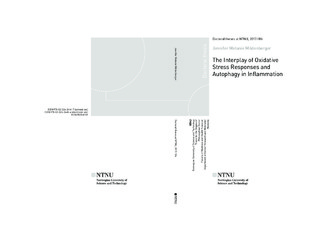| dc.contributor.advisor | Bjørkøy, Geir | |
| dc.contributor.advisor | Flo, Trude Helen | |
| dc.contributor.author | Mildenberger, Jennifer Melanie | |
| dc.date.accessioned | 2017-07-17T08:20:06Z | |
| dc.date.available | 2017-07-17T08:20:06Z | |
| dc.date.issued | 2017 | |
| dc.identifier.isbn | 978-82-326-2445-4 | |
| dc.identifier.issn | 1503-8181 | |
| dc.identifier.uri | http://hdl.handle.net/11250/2448777 | |
| dc.description.abstract | To assure homeostasis, cells have to continuously adapt to exogenous and endogenous threats. This is achieved by response mechanisms like the oxidative stress response, autophagy and inflammation. The oxidative stress response limits the level of damaging reactive oxygen species (ROS), while autophagy removes and recycles damaged proteins. Both processes modulate inflammation, which is essential for cellular defense but also a cause of harm. Exaggerated or insufficient activity of these processes leads to pathologic changes. It is acknowledged that impairment of the maintenance systems and accumulation of damage leads to pathologic changes. The appropriate targeting of cellular maintenance mechanisms could be beneficial for a broad range of pathologies, but demands an in-depth knowledge of endogenous responses. The objective of this work was to study the complex interaction of autophagy, oxidative stress and inflammation and their modulation in disease prevention and infection therapy.
Age-related neurodegenerative diseases are often characterized by the accumulation of protein aggregates, likely as a result of declining clearance mechanisms. Age-related macular degeneration (AMD) is a common cause of blindness in elderly and associated with aggregate deposits in areas where retinal pigment epithelial (RPE) cells and consequently photoreceptors are lost. The cells ability to cope with stress can be influenced by the diet. Omega 3 polyunsaturated fatty acids (n-3 PUFA) have shown beneficial effects on AMD, however, the mechanisms are not understood. We here describe the transient increase of protein aggregation, autophagy and activation of the oxidative stress response by the n-3 PUFA docosahexaenoic acid (DHA). Knockdown of the autophagy receptor SQSTM1 (sequestosome 1), the essential autophagy gene ATG5 (autophagy-related 5) or the regulator of the anti-oxidative response NFE2L2 (nuclear factor, erythroid 2 like 2) resulted in limited cell proliferation during treatment with DHA. Finally, DHA protected RPE cells from cell cycle arrest induced by misfolded proteins or exogenous oxidative stress.
Underlying low grade inflammation contributes to the most common diseases in Western countries and n-3 PUFAs are acknowledged to have anti-inflammatory effects. We investigated if the increase of protein aggregation, autophagy and activation of the oxidative stress response that we had seen in RPE cells, contributes to anti-inflammatory effects of n-3 PUFAs. Our results indicate that n-3 PUFA treatment in macrophages mediated polymerization of the autophagy receptor SQSTM1 (sequestosome 1) and recruitment of KEAP1 (kelch-like ECH associated protein 1), which is the repressor of NFE2L2, as a fast mechanism to activate the anti-oxidative response. Simultaneously, DHA strongly limited IFN (interferon)-dependent signaling. We further show decreased levels of the IFN-stimulated chemokine CXCL10 (C-X-C motif chemokine ligand 10) in n-3 PUFA supplemented patients with chronic inflammation and suggest CXCL10 as a valuable marker for beneficial effects of n-3 PUFAs in inflammation-related diseases.
Responses that protect the host from tissue damage can favor pathogens and dampen the defense against infections. ROS are produced during the uptake of bacteria by immune cells (phagocytosis). ROS represent an important part of defense, while the NFE2L2 -KEAP1 system regulates oxidative stress and limits ROS production. We investigated the role of the ROS sensor KEAP1 in mycobacterial infection. ROS production during phagocytosis recruited KEAP1. Knockdown of KEAP1 in Mycobacterium avium infected cells increased expression of cytokines and type I IFNs and augmented nuclear translocation of upstream transcription factors. Our results indicate that the KEAP1-ubiquitin ligase complex ubiquitinates the signaling protein IKK β (I kappa kinase beta) and marks it for degradation. The down-regulated inflammation resulted in increased intracellular growth and survival of M. avium in human macrophages. | nb_NO |
| dc.language.iso | eng | nb_NO |
| dc.publisher | NTNU | nb_NO |
| dc.relation.ispartofseries | Doctoral theses at NTNU;2017:186 | |
| dc.relation.haspart | Paper 1: Johansson, Ida; Monsen, Vivi Anita Talstad; Pettersen, Kristine; Mildenberger, Jennifer; Misund, Kristine; Kaarniranta, Kai; Schønberg, Svanhild Margrethe Arentz; Bjørkøy, Geir. The marine n-3 PUFA DHA evokes cytoprotection against oxidative stress and protein misfolding by inducing autophagy and NFE2L2 in human retinal pigment epithelial cells. Autophagy 2015 ;Volum 11.(9) s. 1636-1651
http://dx.doi.org/10.1080/15548627.2015.1061170
This is an Open Access article distributed under the terms of the Creative Commons Attribution-Non-Commercial License (http://creativecommons.org/licenses/by-nc/3.0/) | nb_NO |
| dc.relation.haspart | Paper 2; Mildenberger, Jennifer; Johansson, Ida; Kjøbli, Eli; Damås, Jan Kristian; Flo, Trude Helen; Bjørkøy, Geir.
N-3 PUFAs induce inflammatory tolerance by formation of KEAP1 containing p62-bodies
and activation of NFE2L2
Final published version available in Autophagy
Volume 13, 2017 - Issue 9
This is an Open Access article distributed under the terms of the Creative Commons Attribution-NonCommercial-NoDerivatives License
https://doi.org/10.1080/15548627.2017.1345411 | nb_NO |
| dc.relation.haspart | Paper 3: Awuh, Jane Atesoh; Haug, Markus; Mildenberger, Jennifer; Marstad, Anne; Chau, Do Ngoc Phuc; Louet, Claire; Stenvik, Jørgen; Steigedal, Magnus; Damås, Jan Kristian; Halaas, Øyvind; Flo, Trude Helen. Keap1 regulates inflammatory signaling in Mycobacterium avium-infected human macrophages. Proceedings of the National Academy of Sciences of the United States of America 2015 ;Volum 112.(31) s. E4272-E4280
http://dx.doi.org/10.1073/pnas.1423449112
Freely available online through the PNAS open access option. | nb_NO |
| dc.title | The Interplay of Oxidative Stress Responses and Autophagy in Inflammation | nb_NO |
| dc.type | Doctoral thesis | nb_NO |
| dc.subject.nsi | VDP::Medical disciplines: 700 | nb_NO |
